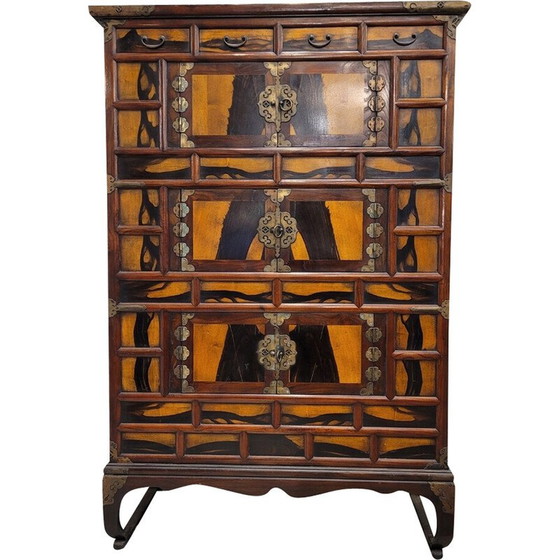Have it delivered hassle-freeBuyer protectionAll items curated by WhoppahDownload the Whoppah app here

Vintage “Samcheungjang” storage unit in Korean pine wood and bronze fittings
Seller: Business seller€6,950Offer from €6,255
Item not as advertised, money backAll items are curated and 100% authenticHave it delivered hassle-free or pick it up yourselfShop only from Trusted Sellers
Business seller
Product description
Korean furniture “Samcheungjang”, fruit wood and bronze fittings, 19th century. XIX – Korea
Extraordinary three-tier Korean wardrobe or chest known as samcheungjang, made in the 19th century during the Choson period (1392 - 1910) in South Korea. The most common are two-level chests, such as the one in the Korean Folk Museum, while three-level chests are less frequent and rarer, as in this case.
Each of these three levels or chests features a pair of paneled doors that open in the center to offer ample storage space. The first module, for its part, presents a row of four small registers or drawers at the top. The entire structure is raised from the ground thanks to four legs, joined by a kind of chamber on the sides, which serves as support and support. Impeccable sense of proportion in the use of straight lines and simple planes.
The frame of this furniture is made of Korean pine wood, visible on the top and on the sides. The façade, however, is configured with meticulously chosen persimmon wood panels (diospyros kaki). It is a wood veneer with a strong two-tone grain, thanks to the dark heartwood, which fits perfectly in the shape of a mirror and looks like bold ink strokes like those in abstract painting. The carpenter craftsmen of the Yi Dynasty loved this wood. It is not used freshly cut, but rather you wait a while for it to become more resistant, sometimes even 10 years. Oil finish to protect it and enhance the shine of the grain.
The Korean Peninsula has a very contrasting climate as summers are hot and humid and winters are cold and dry. These extreme temperatures make the tree rings clearly visible, thus obtaining that incredible bichromaticity. The veneers of these decorative woods are covered on the back with Korean pine or paulownia wood since it does not shrink and prevents cracks.
In the furniture, metal accessories are reduced to a minimum for simplicity. The bronze hardware is relatively small in size and with faint motifs so as not to overshadow the beauty of the wood: drawer handles, corner pieces, petal-shaped hinges, etc. The door lock is very original, through the bronze circumference.
Inside you can see the untreated wood of the frame and some remains of old paper used as a lining. In the lower module there are remains of what appears to be a wax seal, a guarantee of Korean manufacturing.
The function of this piece of furniture in the Korean house was to store clothes. In houses there used to be a female room and a male room, with furniture related to each person's work. The furniture in the anbang was mainly related to clothing storage, grooming, and the lady's duties as a housewife. These furniture were brighter and cheerful compared to the austere furniture in the male rooms. In the richest houses, chests of drawers and other types of furniture could be lacquered, covered with panels of ox horn or silk (smooth or embroidered), inlaid with mother-of-pearl and/or tortoiseshell. Furthermore, anbang furniture tended to use decorative metal elements to a greater extent than furniture in men's rooms.
This piece of furniture is a perfect example of Korean furniture, where simple and discreet beauty, the absence of artificiality, and functionality are the most sought-after virtues. Korean furniture is the result of Korea's cultural environment, its climate, its housing and its customs. The furniture of the Choson period (1392-1910) is a notable example of a sense of proportion and an exact division of the surface, as in this case. Furthermore, in wooden furniture the natural grain of the wood is emphasized over the carving and colorful decoration, something that wonderfully expresses the love for nature. Examining the piece, one can see an extensive and deep patina incurred by its age and previous use. Aesthetically stunning furniture with an unexpected modern touch.
Bibliography: Deprez, M. "Korean Antique Furniture & Accessories", p. 46. (The piece is also illustrated on the cover)
Dimensions: 162 x 110 x 49 cm.
Shipping of the product will be paid by the buyer according to the dimensions, weight and destination. Professional custom-made packaging is included in the shipping costs; and personalized shipping, with tracking number and warranty.
Specifications
ConditionGoodHeight162 cmWidth110 cmDepth49 cm









